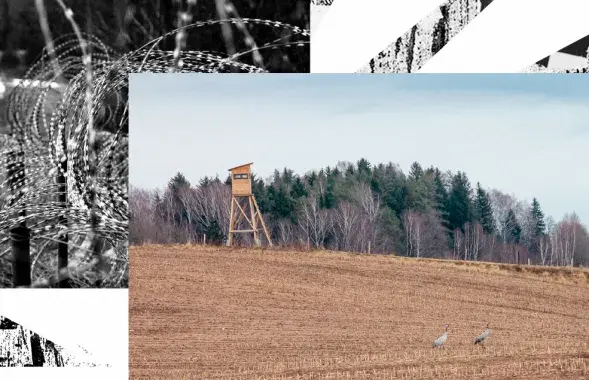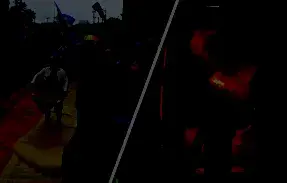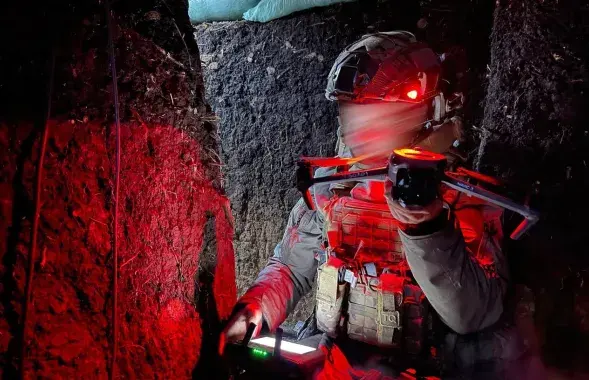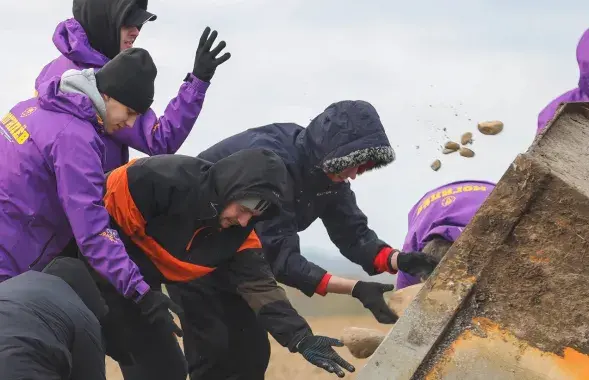Neglected radiation getting into subterranean waters near Stoubtsy and Rechytsa
More and more radioactive waste depots are getting found in the places where Soviet regiments were situated in Belarus while the Belarusian authorities are arguing with Lithuania about the possibility of construction of a nuclear waste depot near the Belarusian-Lithuanian border. A great amount of caesium and strontium has been found in the soil and water there. Moreover, traces of somebody having tried to sap into those depots were left there.
Two nuclear waste depots of Soviet regiments armed with strategic missiles are already known – “Kolasava” in Stoubtsy District of Minsk Region and “Homel-30” in Rechytsa District of Homel Region. It is also known that radioactive waste produced as a result of nuclear war-heads exploitation was hidden in concrete shafts. Nobody knows what kind of waste it was because no documents were left after missiles had been transferred to Russia. According to the head of the laboratory of the Institute of energy and nuclear research Uladzimir Skurat, nobody knows how much nuclear waste remains in Belarus.
Uladzіmіr Skurat: “We cannot answer all questions now, we do not know how many depots there are and where they are located”.
Scientists have been performing research in “Kolasava” and “Homel-30” for several years. They do not think that there is some radioactive danger in the neighbourhood. However, a great amount of caesium and strontium has been found in the soil and water there.
Uladzіmіr Skurat: “All the radioactive nuclides can get into subterranean waters. Contamination of subterranean waters is a much more serious problem. People will get this water and drink it, so they will be exposed to internal irradiation”.
The scientist also thinks that people who like getting everything that is abandoned or neglected will try to get some profit off such depots.
Uladzіmіr Skurat: “Somebody may get to those depots in forests and start doing something there. There were some cases like that and we found traces of saps. There are only concrete shafts, nothing else to steal but anyway there are people eager to dig around”.
Specialists from the Institute of energy and nuclear research are sure that it is dangerous to leave military nuclear waste depots like that.
Uladzіmіr Skurat: “It is necessary to excavate them, to saw them up and to transport the waste to a new depot”.
The Department of industry and nuclear power safety is aware of the fact that there are other mortuaries like that in Belarus. According to the deputy head of the department of radiation safety Vasіl Palyuhovіch, they are controlling only “civilised” depots and have nothing to do with such derelict places like “Kolasava” and “Homel-30”.
Vasіl Palyuhovіch: “Those are depots that have not been deserted and are still under control of the Ministry of Defence”.
However, the official is aware that they do not see any danger in it.
Vasіl Palyuhovіch: “We have made a research but it cannot give evidence of the fact the radioactive nuclides could leave the depot. We do not have any proof that something leaked from this very depot and not from some other”.
ERB asked the press service of the Ministry of Defence about military mortuaries and their future. Its head Mikalau Pyatrou answered that his institution had nothing to do with such depots as “Kolasava” and “Homel-30”.
Mіkalai Pyatrou: “The Ministry of Defence does not supervise these depots. It has a special department called Industrial Nuclear Inspectorate”.
At the same time the head of the laboratory of the Institute of energy and nuclear research Uladzіmіr Skurat claims that some people come to the territory of former Soviet regiments and do something there.
Uladzіmіr Skurat: “Those zones are non-secure. People work there”.
Even the head of the press service of the Ministry of Defence Katsyaryba Shelehava-Samusenkava could not explain ERB what kind of “secure zones” were situated on the territories of former Soviet regiments and what people were doing near the nuclear waste depots.
Photo by — Marc Morte
Two nuclear waste depots of Soviet regiments armed with strategic missiles are already known – “Kolasava” in Stoubtsy District of Minsk Region and “Homel-30” in Rechytsa District of Homel Region. It is also known that radioactive waste produced as a result of nuclear war-heads exploitation was hidden in concrete shafts. Nobody knows what kind of waste it was because no documents were left after missiles had been transferred to Russia. According to the head of the laboratory of the Institute of energy and nuclear research Uladzimir Skurat, nobody knows how much nuclear waste remains in Belarus.
Uladzіmіr Skurat: “We cannot answer all questions now, we do not know how many depots there are and where they are located”.
Scientists have been performing research in “Kolasava” and “Homel-30” for several years. They do not think that there is some radioactive danger in the neighbourhood. However, a great amount of caesium and strontium has been found in the soil and water there.
Uladzіmіr Skurat: “All the radioactive nuclides can get into subterranean waters. Contamination of subterranean waters is a much more serious problem. People will get this water and drink it, so they will be exposed to internal irradiation”.
The scientist also thinks that people who like getting everything that is abandoned or neglected will try to get some profit off such depots.
Uladzіmіr Skurat: “Somebody may get to those depots in forests and start doing something there. There were some cases like that and we found traces of saps. There are only concrete shafts, nothing else to steal but anyway there are people eager to dig around”.
Specialists from the Institute of energy and nuclear research are sure that it is dangerous to leave military nuclear waste depots like that.
Uladzіmіr Skurat: “It is necessary to excavate them, to saw them up and to transport the waste to a new depot”.
The Department of industry and nuclear power safety is aware of the fact that there are other mortuaries like that in Belarus. According to the deputy head of the department of radiation safety Vasіl Palyuhovіch, they are controlling only “civilised” depots and have nothing to do with such derelict places like “Kolasava” and “Homel-30”.
Vasіl Palyuhovіch: “Those are depots that have not been deserted and are still under control of the Ministry of Defence”.
However, the official is aware that they do not see any danger in it.
Vasіl Palyuhovіch: “We have made a research but it cannot give evidence of the fact the radioactive nuclides could leave the depot. We do not have any proof that something leaked from this very depot and not from some other”.
ERB asked the press service of the Ministry of Defence about military mortuaries and their future. Its head Mikalau Pyatrou answered that his institution had nothing to do with such depots as “Kolasava” and “Homel-30”.
Mіkalai Pyatrou: “The Ministry of Defence does not supervise these depots. It has a special department called Industrial Nuclear Inspectorate”.
At the same time the head of the laboratory of the Institute of energy and nuclear research Uladzіmіr Skurat claims that some people come to the territory of former Soviet regiments and do something there.
Uladzіmіr Skurat: “Those zones are non-secure. People work there”.
Even the head of the press service of the Ministry of Defence Katsyaryba Shelehava-Samusenkava could not explain ERB what kind of “secure zones” were situated on the territories of former Soviet regiments and what people were doing near the nuclear waste depots.
Photo by — Marc Morte


















